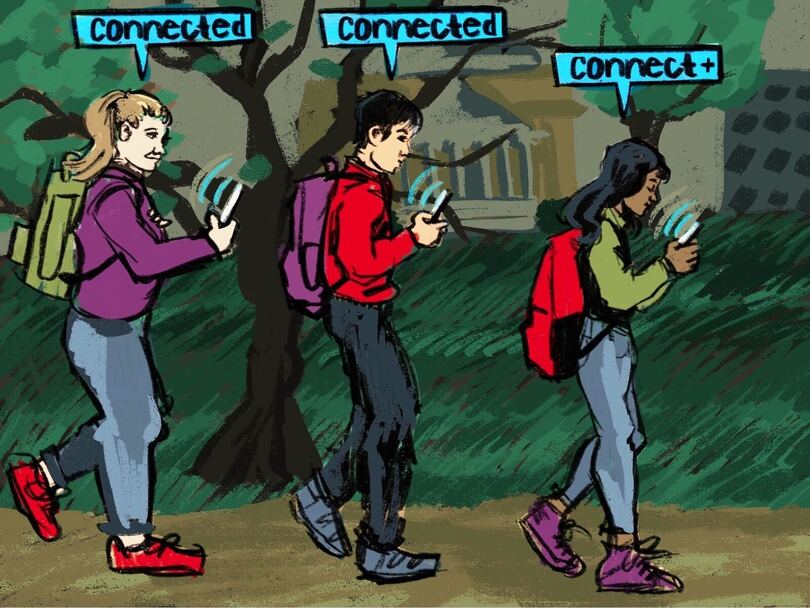Opinion: Gen Z prioritizes appearance of productivity over true connection

Our columnist advises students entering the workforce to use LinkedIn for more than just a numbers game. Real value comes in making real-world connections rather than through random online sources. Julia English | Cartoonist
Get the latest Syracuse news delivered right to your inbox.
Subscribe to our newsletter here.
Based on how much emphasis Generation Z and the greater professional world seem to place on garnering 500 connections on LinkedIn, I’d assume the digital milestone means you get invited to some exclusive club that grants immediate career success.
Unlike all other social media platforms, LinkedIn stops displaying increases in connections once a member reaches 500. While this feature may have been intended to devalue the excessive and meaningless status boost that a high follower count promotes, it seems to have the opposite effect.
LinkedIn’s intended audience is people who want to maintain professional relationships with those they already know. But for Gen Z users who are often fluent in social media, the habit of following and connecting with others that we haven’t actually met doesn’t achieve LinkedIn’s original goal.
Gen Z’s use of LinkedIn sets a standard for the sake of appearance rather than effective, genuine networking.
In other words, even if your pool of professional connections is made up of friends from elementary school and random people who request to connect with you, you’re still a step closer to LinkedIn nirvana.
As college students, we should be taking advantage of our large in-person network on campus as our main source of real world connections. LinkedIn has coldly replaced the traditional practice of in-person networking, even when those connections are more meaningful when formed face-to-face.
Making professional connections is as easy as the click of a button in 2025. It’s much less work than making real-life business acquaintances.
Paying $29.99 per month for a LinkedIn Premium subscription opens up the ability to research potential employers or competitors for the position you’re interested in without them knowing. You can use the tool to stay in the know with friends and competitors alike.
This concept increases the illusion that we’re staying engaged with our networks, when in reality we’re merely keeping up with the calculated, professional versions of our peers. Intermixing our professional lives with our personal lives is often misleading and can become hurtful when making career comparisons.
So while LinkedIn is a positive way to share your professional experiences with friends or attempt to find your dream job, it’s equally a marker of our culture’s continued prioritization of appearance over everything. This cultural phenomenon runs deep in the professional world.
The desire to prove our hardworkingness is ridiculously prevalent in our country. Americans love to look like they “hustle.” To get less sleep and work longer is to wear a badge of honor. Our actual productivity levels may be low, but if we log enough hours — even those spent on self-administered social media breaks — we feel worthy.

Alek Levy | Design Editor
On social media, all sorts of professionals post videos aiming to romanticize their work life in the eyes of others. If you don’t feel fulfilled with your career, whether the work itself feels meaningless or the salary is lacking, making a TikTok montage showing the highlights makes it feel easier for some to digest reality.
While romanticizing a difficult job through posting content on social media might be a good way of making day-to-day life more tolerable, our reliance on these methods is unsustainable long term and reveals a greater issue with our cultural view of work.
In the United States, our identities can be undermined by policies in the workforce that devalue a complex and multifaceted human experience.
As the U.S. maintains its status as one of few countries without paid maternity leave in the world, many new parents are forced back into working before designating time to raise their newborn. These policies, and others that are similar, feed into the idea that one’s professional success is more important than their personal fulfillment.
Posting on LinkedIn about your professional trajectory isn’t the cause of our continual movement toward completely overlapping our professional and personal spheres, but rather a response to it. In many ways, professional success has become the most important element of perceived self-worth.
In other cultures, the concept of work-life balance isn’t a pipe dream, but a balanced, normalized way of living. While this type of culture may not be the norm in the U.S., our still-impressionable generation can take strides to implement it.
By rejecting the commitment to meeting arbitrary measures of success and adhering to our own standards for our personal careers — not everyone else’s — we can find more purpose in our professional journeys.
Maya Aguirre is a junior magazine news digital major. Her column appears bi-weekly. She can be reached at msaguirr@syr.edu.






